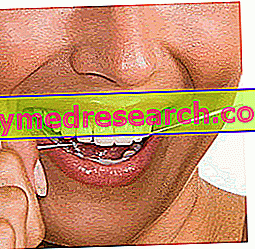Dental abscess: introduction
The diagnosis of dental abscess is rather easy, a simple medical history (collection of symptoms reported by the patient) is often sufficient. The subject affected by dental abscess accuses an unstoppable, pulsating and acute toothache, such as to hinder chewing or - worse still - normal daily activities and night rest.

The prognosis is excellent when the dental abscess is stopped as soon as the first symptoms appear; otherwise, in case of failure to intervene, the dental abscess can cause devastating effects, up to death in extreme cases.
Diagnosis
As mentioned, the diagnosis of a dental abscess is rather simple. An anamnestic investigation (ie the collection of symptoms accused by the patient) is in fact sufficient to hypothesize a current dental abscess. In any case, the dentist proceeds with a specialist examination to verify the infection. The presence of purulent material (bacteria, cellular debris, plasma and white blood cells) in the gingiva, in the mandibular bone or in the pulp of the tooth can be ascertained through appropriate diagnostic-investigative tests:
- Touching the tooth. Many times, the dental abscess makes the teeth extremely sensitive; therefore, a simple brushing of the tooth can sharpen the toothache. To test the intensity of pain, the dentist gently touches or lightly presses the tooth involved in the disease.
- Aspiration: the dentist inserts the needle of a syringe into the inflamed gingival area to aspirate any pus sample. Subsequently, the collection is sent to the laboratory for the examination of bacterial culture.
- Radiography: diagnostic test useful for detecting the severity of dental abscess. Radiographs are generally indicated in the case of broken and chipped teeth, and hypothetical mandibular bone infection.
Therapies and treatments
Dental abscess therapy aims to:
- Kill the pathogens involved in the infection → antibiotics
- Remove pain and all other symptoms → therapeutic aids
- Save the tooth from a hypothetical extraction → immediate intervention
Being an infection, a targeted antibiotic treatment is the most appropriate therapy to effectively eradicate the dental abscess. Often, however, alongside the antibiotic treatment it is necessary to incise the dental abscess to drain its contents . The dentist, with the aid of sterile instruments, proceeds first anesthetizing the area to be treated; subsequently, the doctor makes a small incision in the abscess, to remove the accumulated purulent material.
To combat the inevitable pain that accompanies the dental abscess, the doctor prescribes anesthetic painkillers to the patient (eg ibuprofen, naproxen, acetylsalicylic acid). In the presence of high fever, the most indicated drug is paracetamol.
The most effective solution for a PERIAPICAL ABSCESS (irreversible pulpitis) is the devitalization of the tooth, which avoids a possible extraction. This intervention consists in the removal of the damaged dental pulp, and in its subsequent filling with special amalgams or biocompatible materials. Subsequently, the tooth must be reconstructed: metal and carbon pins can be implanted (to support the reconstruction) and, finally, it is possible to cover the tooth with a capsule.
If the devitalization procedure had not been performed correctly, the dental abscess could create greater damage. In such circumstances, it is necessary to proceed with surgical removal of the diseased tooth.
A periodontal abscess generally requires therapies that are less invasive than in the previous case. The detartarsai (intervention that provides for the professional removal of tartar and plaque), supported by an antibiotic and pain-relieving therapy, is sometimes sufficient to treat the dental abscess. At other times, after carefully cleaning the gingival pocket in which the abscess has formed, it is necessary to reshape the gum tissue to minimize the risk of recurrent infections.
Prognosis
The prognosis of a dental abscess is excellent when the infection is carefully treated during the first stage (very early symptoms) by drainage and antibiotic therapy.
Otherwise, when not treated, the dental abscess can cause very serious complications, such as fistulas, cysts, granulomas, tooth drop, osteomyelitis, infection of the floor of the mouth and septicemia (sepsis). In diabetic, oncologic and severely immunocompromised patients, an untreated dental abscess can give poor prognosis (patient death).
Prevention
The accurate daily oral hygiene, accompanied by professional scaling every 6-12 months, prevents cavities and oral cavity diseases in general, including dental abscesses.
For proper oral hygiene it is necessary ...
- Brush your teeth at least three times a day, possibly right after every meal or snack
- Use quality toothpastes
- Alternate whitening toothpastes (aggressive) with more delicate toothpaste to prevent tooth enamel consumption
- Use dental floss at least once a day
- Rinse the mouth with antiseptic mouthwash and enriched with fluorine
- Use a soft or electric bristle brush if possible
Periodic checks by the dentist can surprise any infection that is still asymptomatic; therefore, a timely intervention on caries, gingivitis or periodontitis (pyorrhea) minimizes the risk of complications avoiding the appearance of dental abscesses.



